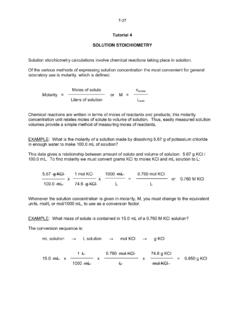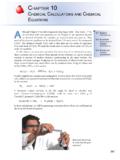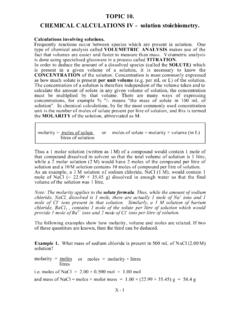Unit 6 Reactions And Stoichiometry
Found 8 free book(s)Tutorial 4 SOLUTION STOICHIOMETRY - EIU
www.eiu.eduChemical reactions are written in terms of moles of reactants and products; this molarity concentration unit relates moles of solute to volume of solution. Thus, easily measured solution volumes provide a simple method of measuring moles of reactants. EXAMPLE: What is the molarity of a solution made by dissolving 5.67 g of potassium chloride
Stoichiometry: Baking Soda and Vinegar Reactions
labsci.stanford.eduStoichiometry: Baking Soda and Vinegar Reactions Teacher Version ... A mole is a unit of measurement just like a “dozen” eggs is 12 eggs. A mole, which was ... it is the number of atoms in 12 grams of carbon, is known as Avogadro’s . Created by LABScI at Stanford 2 Number: 6.02 x 1023. The number of grams in a mole differs from substance ...
Chapter 4 Stoichiometry of Chemical Reactions
web.ung.eduChapter 4 Stoichiometry of Chemical Reactions Figure 4.1 Many modern rocket fuels are solid mixtures of substances combined in carefully measured amounts and ignited to yield a thrust-generating chemical reaction. (credit: modification of work by NASA)
4.3Reaction Stoichiometry
web.ung.edu4.3Reaction Stoichiometry By the end of this section, you will be able to: • Explain the concept of stoichiometry as it pertains to chemical reactions • Use balanced chemical equations to derive stoichiometric factors relating amounts of reactants and products • Perform stoichiometric calculations involving mass, moles, and solution molarity
Chapter 10 ChemiCal alCulations and equations
preparatorychemistry.com10.1 Equation Stoichiometry 369 The ratio of moles of P 4O 10 to moles of P (which came from the subscripts in the chemical formula, P 4O 10) provided the key conversion factor that allowed us to convert from units of phosphorus to units of tetraphosphorus decoxide. Now let’s assume that you have been transferred to the division responsible for the
STOICHIOMETRY OF COMBUSTION
fluid.wme.pwr.wroc.plFUNDAMENTALS: moles and kilomoles Atomic unit mass : 1/12 12 6C ~ 1.66 10-27 kg Atoms and molecules mass is defined in atomic unit mass: which is defined in relation to the 1/12 of carbon 12 6C . Mole: (Avogadro number) 6.022•10 23 atoms Volume of 1 mole (perfect gas) 22.414 l (T= 0 oC, p = 1 atm) Kmole: 10 3 moles Mass of one mole (kmole) is a number of …
Chapter 3 Stoichiometry - Chemistry
www2.chemistry.msu.eduStoichiometry Example C 6H 6 + Br 2-----> C 6H 5Br + HBr Benzene (C 6H 6) reacts with Bromine to produce bromobenzene (C 6H 6Br) and hydrobromic acid. If 30. g of benzene reacts with 65 g of bromine and produces 56.7 g of bromobenzene, …
TOPIC 10. CHEMICAL CALCULATIONS IV - solution …
scilearn.sydney.edu.auStep 6: From the volume of NaOH solution used, its concentration can now be deduced. As 4.170 × 10–3 mole of NaOH are in 25.00 mL, then concentration of NaOH = moles = 4.170 × 10–3 = 0.167 M litres 0.02500 Example 5. Sodium carbonate (10.0 g) is reacted completely with hydrochloric acid (0.115 M).







